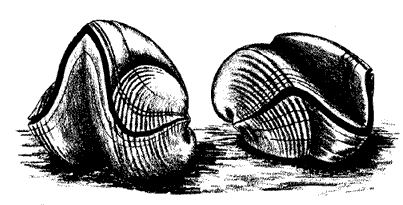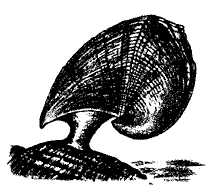
| Palaeos: |  |
Rhynchonelliformea |
| Brachiopoda | Spiriferida |
| Page Back | Page Up | Unit Home | Metazoa |
| Page Next | Page Down | Dendrogram | Glossary |

The Spiriferids proper are characterized usually by the familiar "spirifer" shape with wide or extended hinge line; in fact the hinge-line is often the widest part of the shell, and in some genera (e.g. Mucrospirifer) it is greatly elongated. Nearly all shells bear costae or plications, and they are almost invariably marked by a well-developed sulcus on the pedicle valve and a fold on the brachial valve. The surface is either plicate or coilate and may bear much finer markings. The beak is prominent, and a curved, generally obtuse-angle interarea occurs on the pedicle valve. Directly beneath the beak, the interarea is interrupted by the delthyrium, which may be partly closed by a deltidium.
The spiral brachidium of these brachiopods is remarkably developed, the cone-shaped coils on either side of the median plane being formed of many turns. The spiral brachidia extend outward toward the extremities rather than into the brachial valve. Internal structures are varied, and in some shells they are important in generic diagnosis. Generally, there are large muscle scars, stout dental lamellae, closely coiled, outwardly pointed spiralia, and simple jugum.

Brachyspirifer
Early Devonian
length about 3 cm - width about 4.5 cm
mode of life: had a thick pedicle that probably was attached
to large shells, corals, etc., throughout the animal's life
illustration from Fenton & Fenton, The Fossil
Book, 1958, Doubleday & co., p.120
The spiriferids evolving from the orthids at the end of the Ordovician, developing a coiled brachium independently of the Atrypids and Athyrids. The Spiriferids remain rare during the Silurian, but undergo a dramatic evolutionary radiation during the following, Devonian period, reaching a peak development in variety and numbers at that time. a prominent brachiopod assemblage. Devonian forms were very diverse, including some types with a nonplicated fold and sulcus, various others with evenly spaced coarse or medium to fine plications, and one lineage that is planoconvex in form (i.e. one valve flat, the other bulbous). Cyrtina, with its deep pedicle and opening for a large pedicle, is a well-known Devonian genus. The group undergoes something of a decline during the Early Carboniferous, although still remaining very common (second only to the productids in abundance). Spirifer, a typical genus of this time (top of page), is characterized by plicate shells with a wide hinge line. Late Carboniferous and Permian Spiriferids are characterized especially by bifurcation and bundling of plications on the shell surface. Only a few punctate-shelled forms (which may or may not belong to a distinct order) make it through to the Jurassic.
Spriferidina
(Late Ordovician--Late Permian)
Cyrtioidea (Late Ordovician--Early Devonian)
Spinelloidea (Late Silurian -- Late Devonian)
Theodossioidea (Early Devonian-Early Carboniferous-?Late Carboniferous)
Cyrtospiriferoidea (Early-Late Devonian)
Ambocoelioidea (Late Silurian-Late Permian)
Martinioidea (Late Silurian-Late Permian)
Spiriferoidea (Late Devonian-Late Permian)
Brachythyridoidea (Early Devonian-Late Permian)
Paekelmanelloidea (Late Devonian-Late Permian)
Delthyridina
(Early Silurian-Late Permian.
Delthyridoidea (Early Silurian-Early Devonian)
Reticularioidea (Early Silurian-Late Permian)